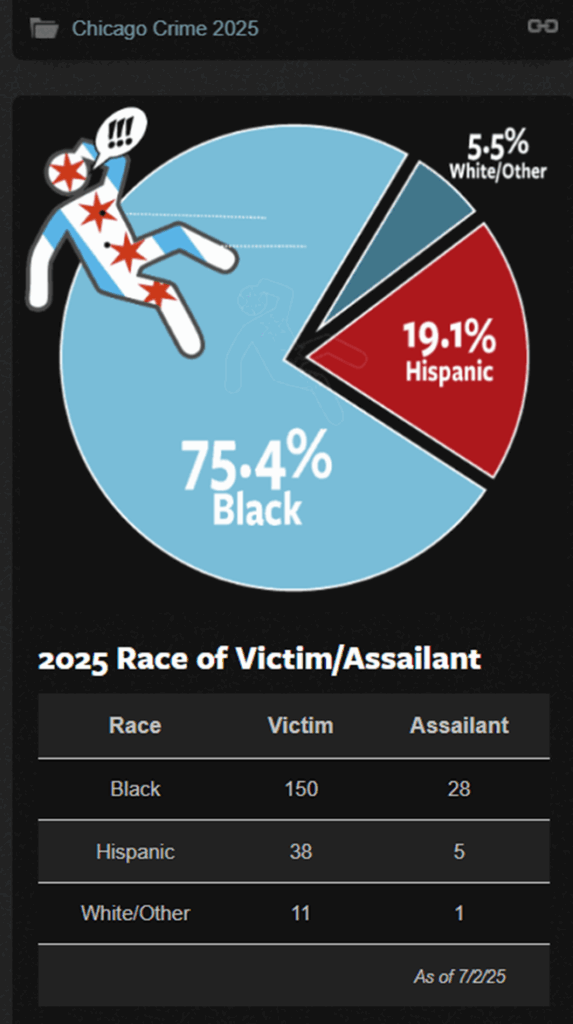Life, Liberty, Property #110: Confidence Rises as U.S. Economy Beats Expectations
Forward this issue to your friends and urge them to subscribe.
Read all Life, Liberty, Property articles here, and full issues here and here.
IN THIS ISSUE:
- Confidence Rises as U.S. Economy Beats Expectations
- Video of the Week: Winning: Gore Fears Climate Realists – The Climate Realism Show #165
- A Pro-American, Pro-Market Immigration Approach
- Driving Up Chicago Crime
- Cartoon
- Bonus Video of the Week: Technocracy Rising! Are We Becoming a Nation of Renters?
Confidence Rises as U.S. Economy Beats Expectations

The June inflation number provided a good deal of ambiguity about whether the Federal Reserve (Fed) is doing right by keeping the federal funds rate at the same high level since this past January when Donald Trump took the oath of office for a second presidential term:

The Consumer Price Index rose by three-tenths of a percentage point on an annual basis in June. The Wall Street Journal attributed this to Trump’s tariffs:

Meanwhile, core PCE inflation, the Fed’s preferred measure, remained steady, the paper noted in a different article:

The same was true of PPI inflation, a third article showed:

Those numbers were significantly below expectations, Trading Economics noted:
Annual producer inflation fell to 2.3%, the lowest since September 2024, compared to an upwardly revised 2.7% in May and forecasts [of] 2.5%. Core PPI also flattened, compared to forecasts of a 0.2% rise and the annual core rate fell to 2.6% from 3.2%, also below expectations of 2.7%.
As to tariff effects, “US Import Prices Rise Less Than Expected,” Trading Economics reported:
US import prices edged up 0.1% from the previous month in June 2025, below market expectations of a 0.3% increase, following a 0.4% decline in May. Nonfuel import prices rose 0.1%, driven by higher prices for nonfuel industrial supplies, materials, and consumer goods. These gains more than offset declines in prices for food, beverages, and motor vehicles. Meanwhile, fuel import prices fell 0.7%, as lower natural gas prices outweighed a rise in petroleum costs. On an annual basis, import prices dropped 0.2% in June, matching the year-over-year decline seen in May.
Meanwhile, U.S. export prices rose more than expected, Trading Economics reported:
Export prices in the US rose 0.5% month-over-month in June 2025, following a 0.6% decline in May and beating expectations for a flat reading. Nonagricultural export prices increased 0.5%, as higher prices for nonagricultural industrial supplies and materials, consumer goods, and automotive vehicles more than offset lower prices for capital goods. Agricultural export prices climbed 0.8%, driven by higher prices for meat and soybeans that outweighed lower fruit prices. On a yearly basis, export prices rose 2.8%. Export prices in the BLS index exclude tariffs but may still reflect their impact through market behavior changes.
In addition to all that, retail sales “surged” (both in nominal and inflation-adjusted terms: “0.6% month-over-month in June 2025, after declines in the prior two months, and beating market expectations of a 0.1% gain,” per Trading Economics), …

Via ZeroHedge
… manufacturing increased rapidly (“The Philadelphia Fed Manufacturing Index surged to 15.9 in July 2025, its first positive reading after three consecutive months in negative territory and the highest level since February”—Trading Economics), jobless claims fell (beating market expectations by 15,000 jobs), and the three-month and six-month annualized inflation numbers remained cool:

In light of those numbers, economists have backed off of their prior forecasts that the Trump tariffs would bring on stagflation, The Wall Street Journal noted:
Economists this month dialed back their earlier pessimism that U.S. trade policies would lead to slower growth and higher inflation this year—at least for the near term. Their latest forecasts in the quarterly Wall Street Journal survey showed a reduced chance of recession and stronger gross domestic product growth in the second quarter.

… Economists lowered the likelihood of a recession in the next 12 months to 33%, down from 45% in April—but still higher than the panel’s 22% consensus in the January survey. Historically, a reading of 33% in the WSJ survey is slightly elevated.
The public likewise got off the stagflation-prediction bandwagon, the University of Michigan consumer sentiment survey indicated, as Trading Economics reported:

Source: Trading Economics
The improved consumer sentiment has been driven by much-lower inflation expectations among Democrats and independents, ZeroHedge noted:


Bottom line: the economy is beating expectations.
Sources: The Wall Street Journal; The Wall Street Journal; The Wall Street Journal; Trading Economics; Trading Economics; Trading Economics; The Wall Street Journal; Trading Economics; ZeroHedge

Video of the Week

Losing the 2000 election was the best thing to happen to Al Gore. He has since become insanely wealthy and admired around the world by peddling climate alarmism. Hollywood gave him an Oscar for his fictitious documentary An Inconvenient Truth, and (like Michael Mann) he claims to be a Nobel Peace Prize winner for his environmental activism. Yet despite trillions of dollars in propaganda, there’s a sign that Gore’s message of doom is in big trouble: He gave a TED Talk attacking “climate realists” by name. That’s BIG, folks—it shows that the truth, the data, and reality are winning.

A Pro-American, Pro-Market Immigration Approach

The debate on the political right over immigration has been particularly tense because of two seemingly incompatible concerns: economic expansion (especially in light of the low and decreasing birth rate among native-born Americans) and cultural/national cohesion.
The U.S. population has risen by 77 percent since the Immigration Law and Nationality Act of 1965 removed national-origin quotas and unleashed chain migration and other expansions of immigration just as the post-World War II baby boom was ending:

The nation’s foreign-born population rose from 9.6 million in 1965 to 46.2 million in 2022—from just under 5 percent of the population to nearly 14 percent:

Source: Migration Policy Institute
Mass immigration has benefited power interests on right and left alike. Much of the American right has long advocated high immigration in service of business interests that benefit from lower labor costs (due to the increased supply through importation of new workers) and higher prices (due to increased demand likewise.) The American left has advocated mass immigration in the belief that immigrants would vote for Democrats out of gratitude (which seems to have been true until Donald Trump entered politics).
The radicals on both the left and right got what they wanted. Note that the descendants of the foreign-born residents of the United States are (understandably) not counted as foreign-born, so the demographic and cultural composition of the nation has changed far more than the percentage of immigrants indicates. Conservatives concerned about the sustainability of the nation’s culture under these conditions clearly have valid concerns.
Those concerns conflict with libertarian-oriented conservatives’ worries that the rapidly aging U.S. population cannot sustain itself without massive injections of foreign laborers. The European Union and its constituent national governments have allowed mass immigration for this very reason. That has unleashed turmoil on the continent as the native population has been systematically displaced by immigrants with much less loyalty to Western liberal values, just as some American conservatives have long warned was in store for the United States.
I am by no mean convinced that the exceedingly resourceful people of the United States could not adjust to the aging of its population if given a chance, and I find it highly interesting that we have rapidly expanded our welfare state since Barack Obama took office as president in 2009, taking millions of people out of the workforce. It is clear that there are millions of Americans who are perfectly able to work and do not do so. Policy could change that.
Even if we concede that the nation needs more young workers and that they must be taken from other countries, the post-1965 system is surely not the only way to accomplish that. Political analyst Josiah Lippincott addresses that very question in an important article at his Regime Critic Substack.
Lippincott starts with a powerfully direct and accurate criticism of the premise behind the post-1965 immigration system: “Immigration policy is meant to benefit immigrants; it is not intended to benefit the founding or native stock of the nation.”
Lippincott acknowledges that libertarians can rightly argue that this formulation is not what they intend:
There are, for instance, real benefits from access to a larger labor pool. Labor is an input into production like any other. Access to foreign markets and foreign goods and therefore foreign labor makes Americans’ [sic] materially wealthier by increasing the number of goods available for purchase. The Founders, for instance, considered access to foreign trade to be part of the natural rights of all men. Cheap goods are, all other things being equal, better than expensive goods.
Lippincott is right: libertarians have gone along for the ride and have not been the ones steering the vehicle. All the political appeal of mass immigration has been in the expected voting power the Democrats received from this policy regimen. If libertarians were driving this process, immigrants would have no access to welfare. Instead, we have this, as Lippincott notes:
The supposed economic benefits of immigration in our current system are vastly overstated. Immigrants who come here both legally and illegally get access to schools, health care (ER rooms functionally cannot turn anyone away), police protection, and American courts of law. Many of these foreigners do not pay taxes because they work in all-cash businesses. A huge percentage of illegal immigrants get access to welfare payments because they have fake documents.
The nation’s current immigration system is enormously destructive, Lippincott argues:
Put simply, our current immigration policy is a mess. We need mass deportations. We need to dramatically reduce the number of green card holders and new naturalizations. America is not better off by making a bunch of Somalis, Afghans, Guatemalans, and Chinese new American citizens. This policy does not benefit our social order. In fact, our new polyglot nation has seen a dramatic decrease in personal liberty and economic vitality as more and more incompatible foreigners pour into our country from all over the world.
While the leftist-designed immigration system thwarts the desires of libertarian-oriented conservatives, it also undermines the cultural cohesion that traditionalist conservatives prize, Lippincott observes:
But cheap goods are not better than sovereignty. It is dangerous and deeply unwise to trade short term material prosperity for long term political instability. Making endless numbers of foreigners into citizens creates that instability by eroding the basic understanding of justice that animates the regime.
Having identified those two concerns, Lippincott addresses the question of whether there is a possible system that could provide the workers libertarians want without undermining the nation’s cultural cohesion (or what remains of it at this point):
But let us dream for a moment. Let us imagine that we succeed. Imagine that we do deport the foreign hordes, secure the border, and re-establish law and order in our communities. Imagine for a moment that the fentanyl dealers are gone, the streets are clean, and America is substantially more cohesive and happier than it is now. What then?
In a world where America First is accepted as a watchword, what would our immigration policy look like? … There is a world in which foreigners, instead of suckling at the American taxpayer tit, are, by a vast margin, net contributors to our national life. In this hypothetical, foreigners really would make America better for Americans.
Lippincott’s plan is simple: divorce residency from citizenship and allow residency only for real, taxpaying work: “The United States could have the best of both worlds by utilizing a guest worker program to bring in foreigners to work but not to become citizens.”
This system would have multiple positive effects, including a possible elimination of the national income tax, Lippincott writes:
These workers could be tariffed (or taxed) at the same rate as foreign goods. Done right, the revenue from these guest workers and foreign goods could be enough to almost entirely eliminate the income tax on American workers.
Let’s look at some back of the paper math. In 2024, the United States collected some $2.4 trillion in income taxes from the American people.
There are 50 million immigrants in America. Their average household income is $75,000 a year. In 2024, we also imported $4.1 trillion worth of goods and services.
Let us imagine that the United States imposed a 50% across the board tariff on all goods and services from abroad, including income made by foreigners in the United States. Assuming some inelasticity of demand, we can expect imports and immigrant wages to fall by about a third.
This means we would bring in about $2.7 trillion in goods and $1.3 trillion in tariffs. Meanwhile, if we imagine that 30 million foreign workers would willingly choose to come to America to work under this regime (very plausible) at, on average a salary of $50,000 a year (2/3 the current total) a 50% tax rate would bring in $750 billion.
In other words, the total revenue of a blanket 50% across the board tariff on all foreign goods and income could plausibly yield more than $2 trillion in annual revenue, enough money to effectively eliminate the income tax for Americans.
Lippincott delves further into the details of this proposal, and I invite you to read it at the “Source” link below. It is also important to note that Lippincott includes policies to reduce or eliminate potential bad incentives and moral hazard, such as this:
In this scenario, a free market guest worker program would allow companies to hire foreigners and bring them to America as long as they were willing to pay the 50% income tariff to do so. This tax regime would automatically grant a huge leg up to American workers. Because Americans would not come with such a tax, these foreigners would have to either be substantially more efficient than American laborers or they would have to do jobs that Americans quite literally were not willing to do because they could make so much more money doing something else.
In this framework, every foreign worker in America would be a symbol of our liberation from income taxation and the government surveillance that comes with it. Corporations that constantly whine about a lack of available labor could have as much of it as they like… as long as they are willing to pay into our common treasury to get it.
Lippincott’s proposed framework would give everyone except leftists what they say they want—more workers and preservation of social order without further undermining national cohesion:
Right now, the United States has sky-high income taxes and low tariffs. We can and should reverse that trend: high tariffs and low (or non-existent) income taxes.
Foreign workers should be just that: workers. They should not be here to grift, get welfare, commit crimes, or agitate for foreign causes.
Simply articulating what an America First guest worker program could look like reveals just how broken our current system is. Foreigners today are allowed license to absolutely run wild in our country. They receive all the rights of citizenship and additional privileges (due to DEI) that are denied to the native population.
This is obscene. Americans should have privileges that foreigners don’t. The greatest privilege we could offer Americans is protection of their rights and liberties that they do not have to pay for out of pocket. We can build a healthy social order and make foreigners pay for it.
Lippincott acknowledges that his proposal is merely a thought experiment at this point, and he states that the United States may not be able to allow significant further immigration at this time without significant political and cultural damage. Nonetheless, Lippincott argues, “an immigration policy motivated by patriotism instead of treason” is a goal well worth pursuing.
I agree, though it certainly would not be long before activists started agitating to give these wonderful foreign-born toilers and their descendants “a path to citizenship.” Still Lippincott’s plan is vastly better than what we have today, and an immigration policy that gives both major factions on the right what they most want would be a big political winner.
Source: Regime Critic
NEW Heartland Policy Study
‘The CSDDD is the greatest threat to America’s sovereignty since the fall of the Soviet Union.’

Driving Up Chicago Crime

A local government-sponsored oversight group is recommending that the Windy City severely limit the kinds of traffic stops Chicago Police Department officers are allowed to do. The reason: disparate impact.
The excellent CWB Chicago (CWBC) website reports:
The Community Commission for Public Safety and Accountability (CCPSA), the civilian panel responsible for overseeing the Chicago Police Department, is wrapping up a public comment period as it weighs major restrictions on the types of traffic stops CPD officers are allowed to make.
The group is taking public input through Monday but has already outlined a list of restrictions most of its members support. Among them: barring traffic stops for plates expired less than a year, improperly displayed or missing front license plates, improper rear license plate lighting, having a single non-functioning head-, tail-, or brake lights during daylight hours, and driving with a loud sound system.
A minority of CCPSA commissioners also support banning stops for failure to wear seat belts or failure to signal turns or lane changes. Some community members are pushing to go even further—calling for a ban on stops for tinted windows, among other minor violations.
Most drivers pulled over by police in Chicago are black or Latino, according to the local PBS station, CWBC reports:
“More than 44% of all drivers stopped by police officers in 2024 were Black, and nearly 35% of drivers pulled over by Chicago police officers were Latino. By comparison, just 14.8% of drivers stopped by Chicago police were White,” WTTW reported, citing a paper published by a coalition of groups seeking to change traffic stop policies.
Even if one believes that people of different ethnic and/or racial groups commit traffic violations in identical proportions—a completely unfounded and extremely implausible assumption—there are other reasons to doubt the PBS station’s implicit complaint, the CWBC story observes:
That conclusion assumes that “fair” traffic enforcement would result in stops that mirror the city’s racial makeup—an assumption that some observers say is flawed. White residents may be less likely to drive or even own vehicles because they tend to live in walkable, transit-rich neighborhoods. Meanwhile, Black and Latino residents may spend more time behind the wheel and could be statistically more likely to work in driving-intensive roles, such as delivery or ridesharing. Financially well-off residents may also be far more likely to spend disposable income on frequent rideshares instead of driving.
The public TV station also ran a claim that the traffic stops do not reduce crime, which CWBC refutes as obviously inane:
“They are using traffic stops to fight crime but there is no evidence that it works,” an ACLU representative told WTTW earlier this year. However, the outlet did not explain how the group determined that the thousands of guns seized during traffic stops in recent years would not have been used in crimes had they remained on the street.
As evidence for this point, which is obvious to anyone not deluded by racial and ethnic bias, CWBC documents “several recent Chicago cases in which police made arrests during traffic stops—including machine gun-related charges—that could soon be off-limits under CCPSA’s recommendations.” (Read the CWBC article for the examples—it provides a half-dozen.)
The notion that police should perform traffic stops in proportion to the color of the driver is patently ludicrous, yet race mongers insist on it. Such a policy would leave many more criminals on the streets, further inflame racial divisions, and result in many more murders of blacks and Latinos, as the latest numbers at the crime-reporting website Hey Jackass prove:

Source: Hey Jackass
Chicago’s crime numbers highlight the deadliness, irresponsibility, and absurdity of basing law-enforcement efforts on the race of the perpetrator.
Sources: CWB Chicago; Hey Jackass
Cartoon

via Townhall
Bonus Video of the Week

Is America quietly shifting from a nation of property owners to a nation of renters? In this episode, we expose the growing forces behind the decline in homeownership—from skyrocketing prices to the corporate consolidation of housing. How is this trend impacting society and the political landscape? Plus, we dive into another urgent emerging issue: the rise of Central Bank Digital Currencies (CBDCs) and what they mean for your financial freedom.

Contact Us
The Heartland Institute
3939 North Wilke Road
Arlington Heights, IL 60004
p: 312/377-4000
f: 312/277-4122
e: [email protected]
Website: Heartland.org








